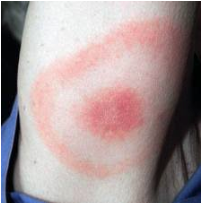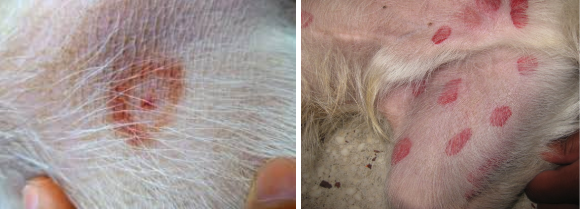Tis the season for black flies and ticks! This time of year, we get a lot of calls from concerned owners who think that their dog has a bullseye mark from a tick bite. The interesting fact is that dogs don’t get the stereotypical bullseye that we associate with tick bites and Lyme disease. The bullseye can only be seen, sometimes, in humans who have been bitten by ticks. Lyme disease in dogs is commonly indicated by a shifting lameness, fatigue, loss of appetite and sometimes, they don’t even show any signs at all. Below, is an example of a bullseye that can be associated with tick bites on a human.

These examples below are of black fly bites on a dog. Thankfully, they usually look worse than they actually feel and most dogs don’t bother at them too much. In most cases, we don’t treat black fly bites unless they are extremely bothersome to the dog, or if they become infected. It is most common to find these bites in the groin area, belly, face, or anywhere that the skin is exposed, with minimal amounts of hair.

If you have concerns about ticks, please don’t hesitate to contact us and we are happy to help answer any questions you might have, in regards to ticks and tick prevention. Unfortunately, we do not have prevention for blackflies, as we do for fleas and ticks. Some tricks I’ve heard include tying a dryer sheet around their collar or using small amounts of child safe bug spray.
Written by Kelsey Hewgill, RVT




